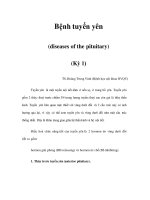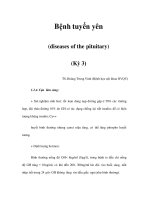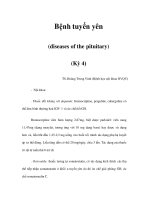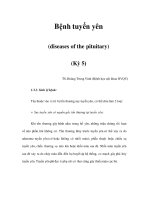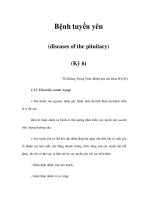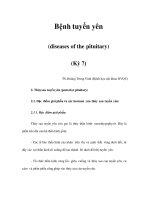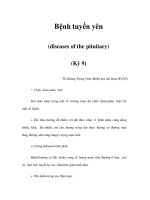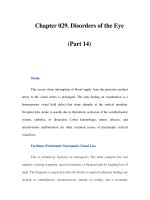disorders of the pituitary gland
Bạn đang xem bản rút gọn của tài liệu. Xem và tải ngay bản đầy đủ của tài liệu tại đây (2.21 MB, 113 trang )
CHAPTER 56
ENDOCRINE SYSTEM
Disorders of the Pituitary Gland
PG. 947
Acromeg aly (Hype rpituitaris m):
A condition in which an over secretion of GH
(gro wth hormone ) occurs after the epiphyses
of the long bones have sealed
Results of hyperplasia (increase in the number
of cells) or a tumor of the anterior pituitary.
S/S of Acromegaly
S/S: coarse features, a huge lower jaw, thick
lips, a thickened tongue, a bulging forehead, a
bulbous nose, and feet (fig 56-1)
The heart, liver, and spleen may be enlarged.
Despite enlarged tissues, muscle weakness is
common, and hypertrophied joints may become
painful and stiff
Osteoporosis of the spine and joint pain
develop.
Acromegaly
Medical Management
Treated by surgical removal of the pituitary
gland or by radiation therapy with consequent
destruction of the pituitary.
Even if the disease is arrested successfully,
physical changes are irreversible.
If the tumor is removed or destroyed by
radiation therapy, replacement therapy with
thyroid hormone, corticosteroids, and sex
hormones is necessary
Simmond’s Disease
(Panhypopituitarism) PG. 949
Simmond’s dis e as e is a rare disorder caused
by destruction of the pituitary gland followed
by an absence of pituitary hormonal activity.
Events such as postpartum emboli, surgery,
tumor, and TB can destroy pituitary function.
S/S Simmond’s Disease
The gonads and genitalia atrophy.
S/s of hypothyroidism, hypoglycemia, and
adrenal insufficiency are apparent.
The client ages prematurely and becomes
extremely cachectic.
Medical Management
Administration of substitute hormones for the
glands that depend on the pituitary for
stimulation.
If untreated, the disease is fatal.
Assess the client’s mental status, emotional
state, energy level, and appetite.
Diabetes Insipidus pg 950
An endocrine disorder that develops when there
is insufficient antidiuretic hormone (ADH) from
the posterior pituitary gland.
Can be caused by head trauma that damages
the pituitary and by primary or metastatic brain
tumors.
S/S
Urine output for a 24 – hour period may be as high as 20
liters (20,000 mL)
The urine is dilute, with a specific gravity of 1.002 or
less.
The excretion of urine cannot be controlled by limiting
the intake of fluids
The need for drinking and voiding frequently limits
activities
Weakness, dehydration, and weight loss develop.
Medical Management
Desmopressin (DDAVP) nasal solution and
lypressin (Diapid) nasal spray are synthetic
drugs with ADH activity that reduce the urine
output to 2 to 3 L/24 hours.
IV fluids if unable to take po.
Syndrome of Inappropriate
Antidiuretic Hormone Secretion
SIADH—characterized by renal reabsorption of
water rather than its normal excretion.
Causes include lung tumors, central nervous
system disorders, brain tumors, CVA, head
trauma, and drugs such as vasopressin, general
anesthetic agents,m oral hypoglycemics, and
tricyclic antidepressants.
Continued release of ADH results in ↑ fluid
volume and hyponatremia.
S/S
Water retention, HA, muscle cramps, and
anorexia develop.
As the condition becomes more severe,
nausea, vomiting, muscle twitching and
changes in the LOC occur.
Medical Management
Treatment is aimed at eliminating the
underlying cause
Osmotic diuretics, such as mannitol and loop
diuretics, including lasix, help to correct water
retention. Severe hyponatremia is treated
with IV administration of a 3% hypertonic
sodium chloride solution.
Nursing Management
S/s of fluid overload: confusion, dyspnea,
pulmonary congestion, hypertension
S/s of hyponatremia: weakness, muscle
cramps, anorexia, nausea, diarrhea, irritability,
HA, and weight gain without edema.
Disorders of the Thyroid Gland
PG. 951
Thyroid disorders include hyperthyroidism,
thyrotoxic crisis, hypothyroidism, thyroid
tumors, and endemic and multinodulal goiters.
Hyperthyroidism
Also called Graves disease, Basedow’s
disease, thyrotoxicosis, or exophthalmic goiter.
May be autoimmune or inherited disease.
Symptoms are from mild to severe
Restless despite feeling fatigued and weak,
highly excitable, and constantly agitated
Fine tremors of the hands occur, resulting in
unusual clumsiness ( 56-4)
Graves Disease
Hyperthyroidism
Cannot tolerate heat, and experience an
increased appetite with weight loss.
Diarrhea also occurs.
Visual changes, such as blurred or double
vision, can develop.
Exophthalmos, seen in client with sever
hyperthyroidism, is due to enlargement of
muscle and fatty tissue that surrounds the rear &
sides of the eyeball
S/s in Table 56-1 PG 952
Hyperthyroidism
Medical Management
Antithyroid drugs are given to block the
production of thyroid hormone.
Potassium iodide (Lugol’s solution) is prescribed
in combination with an antithyroid drug.
Antithyroid medications should be avoided
during pregnancy because they can induce
hypothyroidism, or cretinism, in the fetus.
Nursing Management
Monitor heart rate and BP
Record sleep pattern and daily weight
May take several weeks before thyroid
medication effective.
If radioactive iodine is used to destroy thyroid
tissue, tell the client that it does not seriously
affect other tissues.
Radioactive Iodine
Thyrotoxic Crisis
An abrupt form of hyperthyroidism that is a life-
threatening event.
Thought to be triggered by extreme stress,
infection, diabetic ketoacidosis, trauma,
toxemia of pregnancy, or manipulation of a
hyperactive thyroid gland during surgery or
physical examination.
Thyrotoxic Crisis
S/S: Temperature may be as high as 106 F
Pulse rate is rapid, and cardiac arrhythmias
are common
Persistent vomiting
Extreme restlessness with delirium
Chest pain
dyspnea

